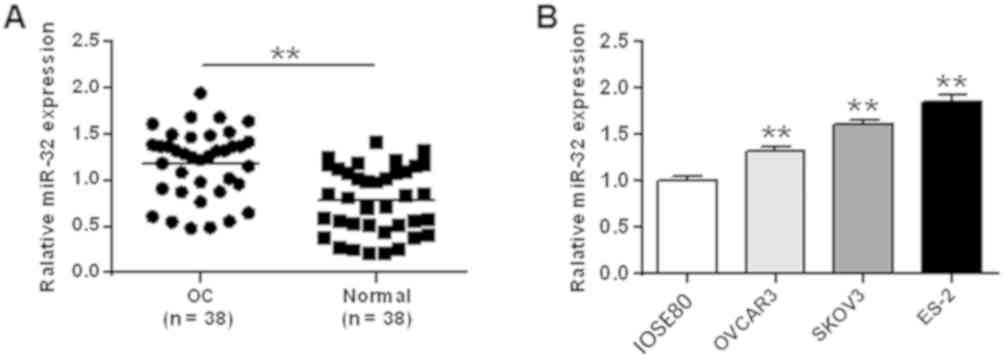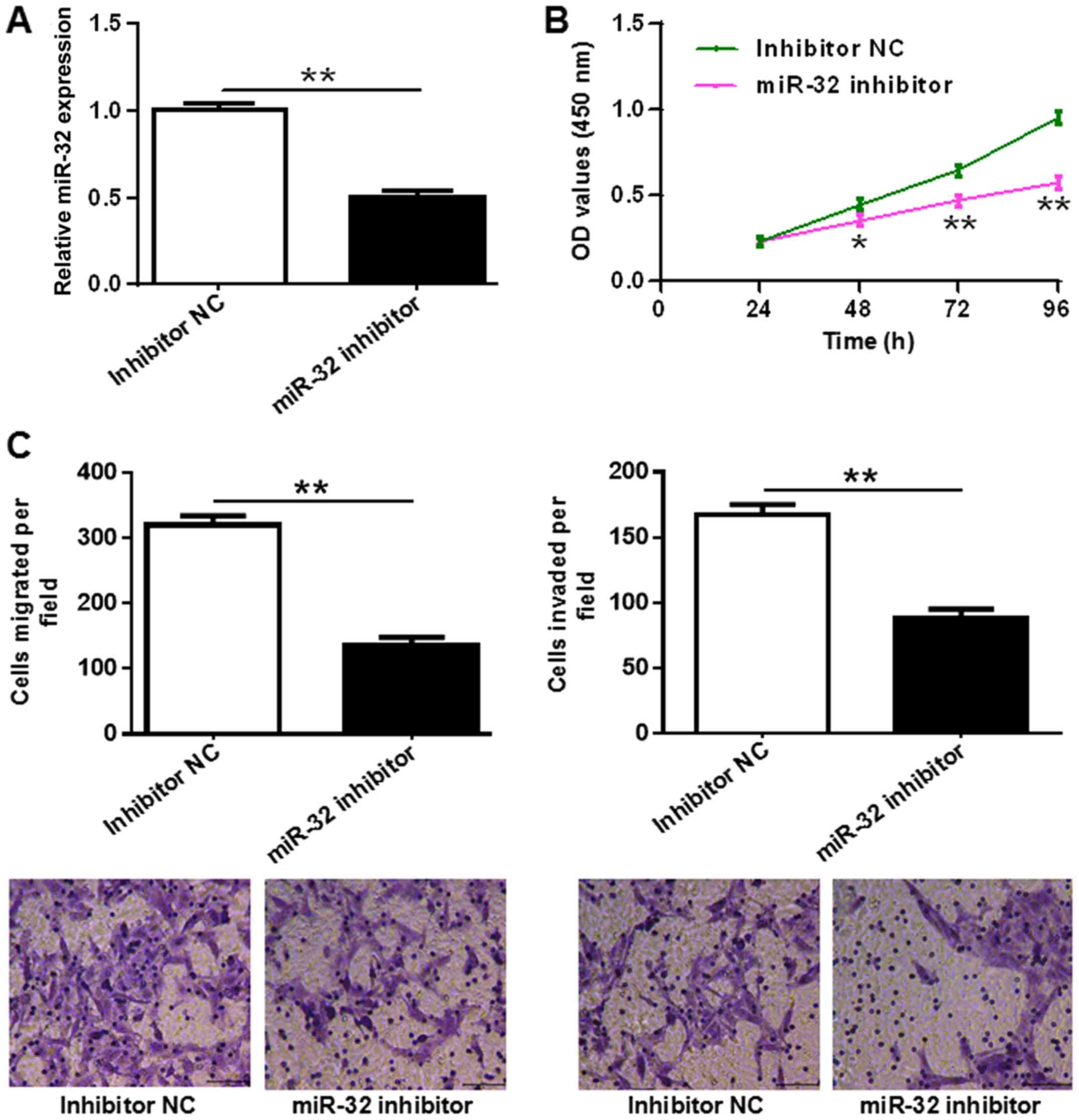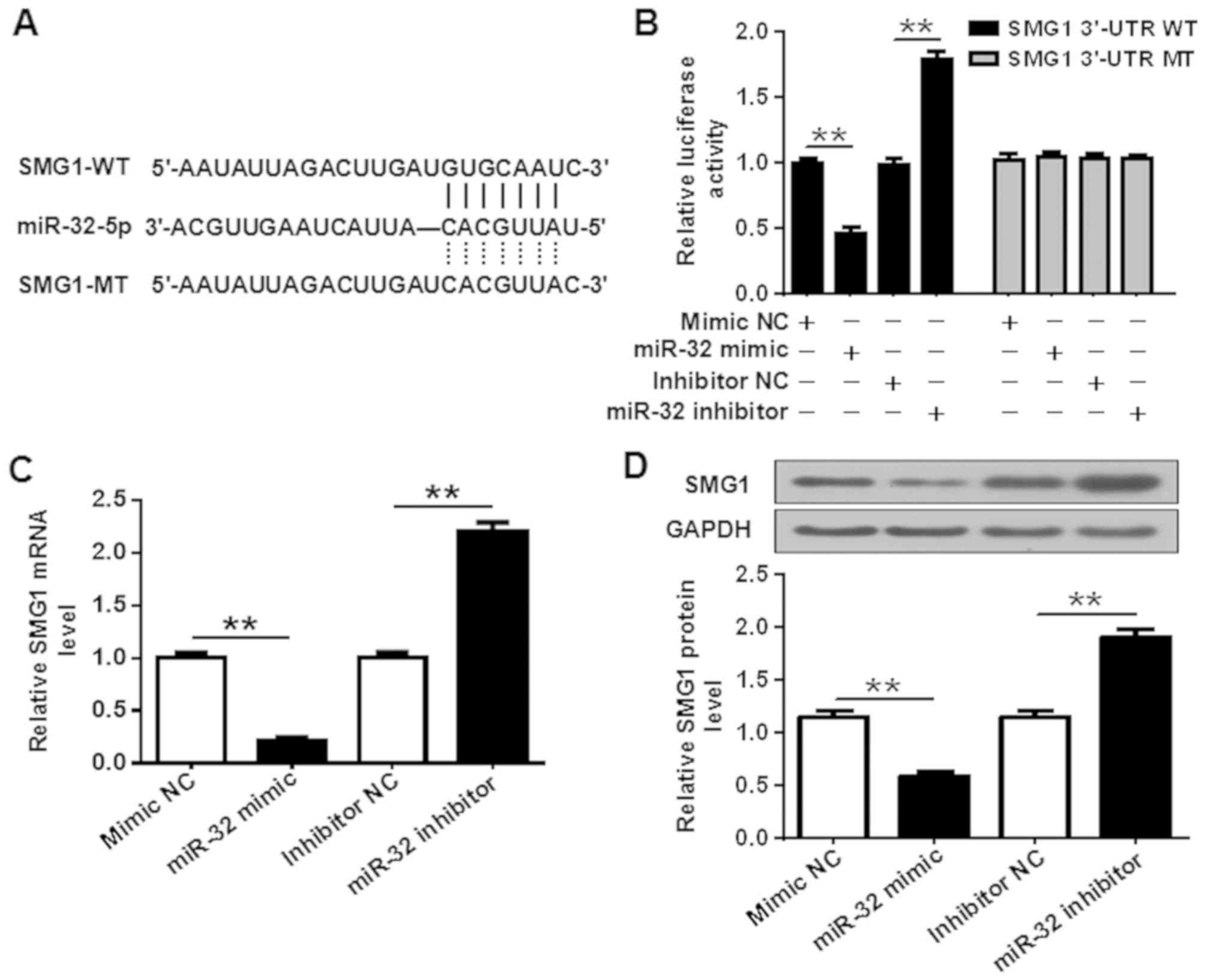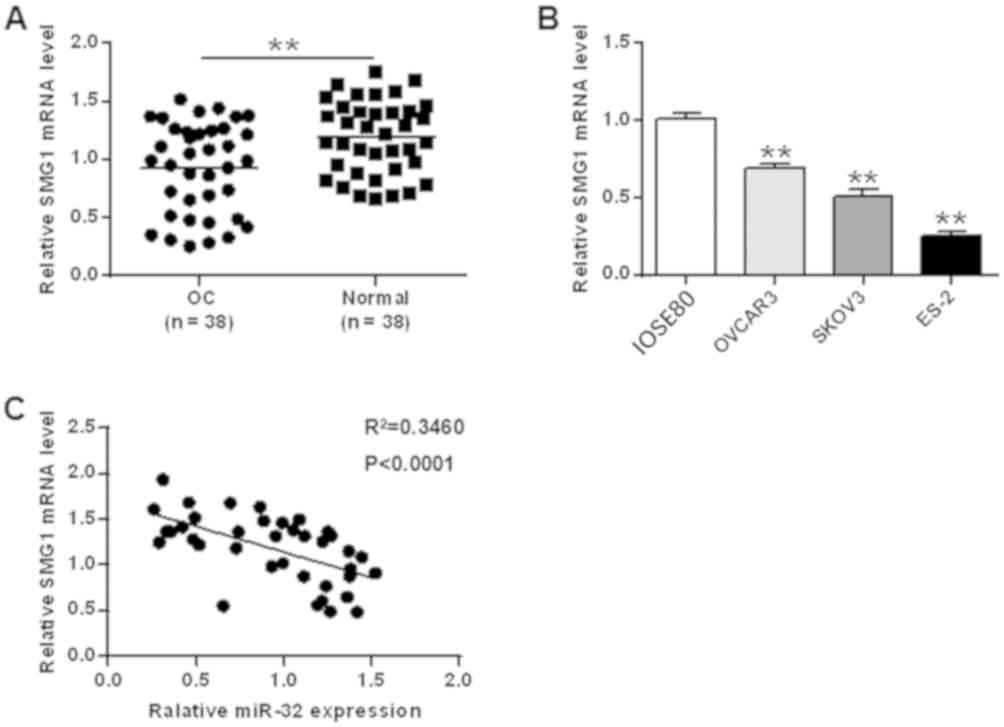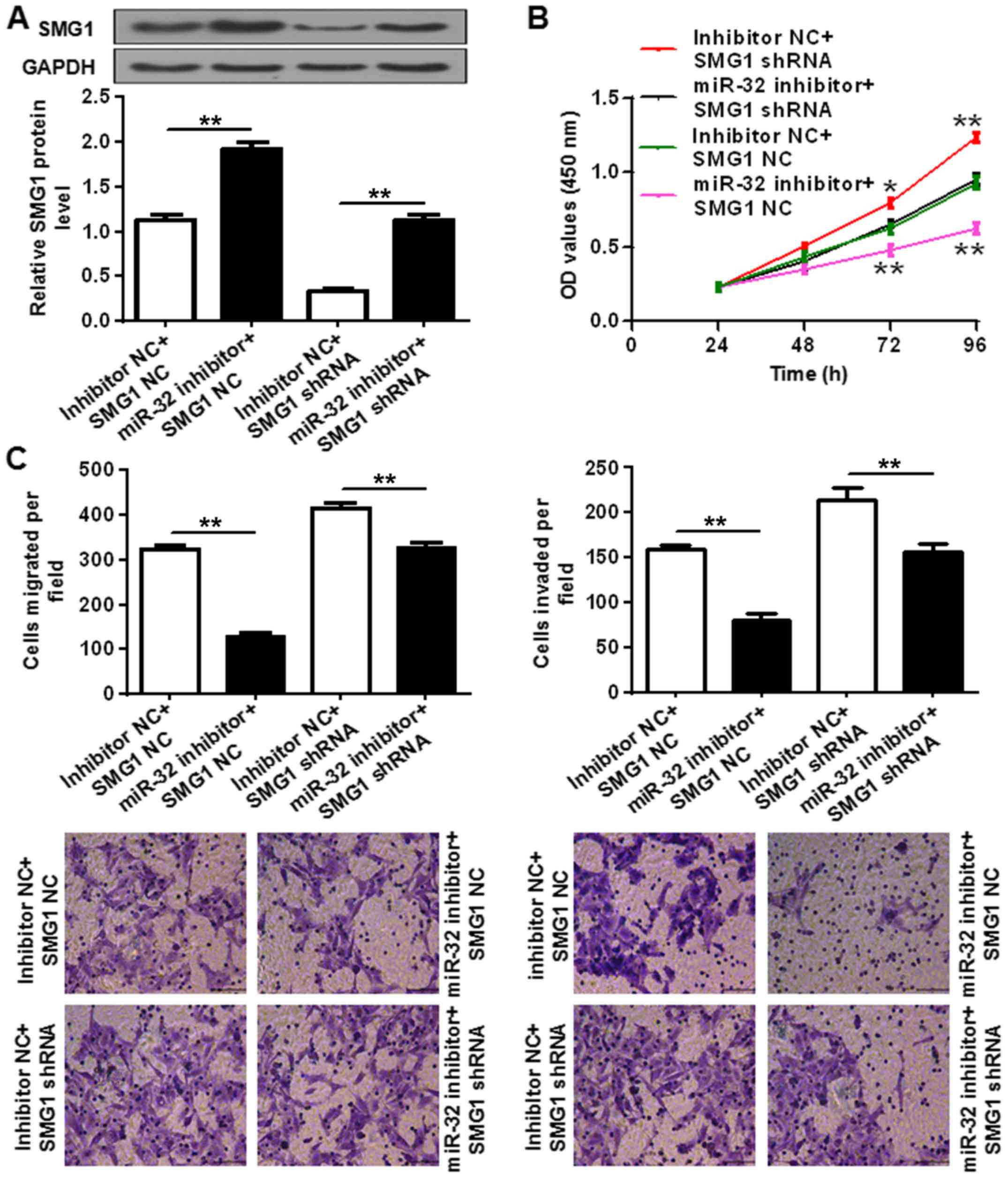MicroRNA‑32 promotes ovarian cancer cell proliferation and motility by targeting SMG1
- Authors:
- Published online on: May 14, 2020 https://doi.org/10.3892/ol.2020.11624
- Pages: 733-741
-
Copyright: © Zeng et al. This is an open access article distributed under the terms of Creative Commons Attribution License.
Abstract
Introduction
Ovarian cancer (OC) is the most lethal gynecological malignancy and one of the leading causes of cancer-related deaths in women (1–3). The high mortality rate is due to the late diagnosis or advanced stage of at the time of diagnosis, with the majority of patients possessing stage III–IV cancer (2). The incidence of OC is still increasing. Currently, the most commonly used therapeutic strategies are surgery and chemotherapy, with radiotherapy occasionally being used (4–6). However, the 5-year survival rate is only ~50% due to the development of recurrent disease that is often resistant to chemotherapy (7). The treatment of recurrent OC is limited and recurrence of OC is still considered as incurable. Thus, the development of new and efficient therapeutic strategies is urgently needed.
MicroRNA (miRNA/miR) is a small non-coding RNA, 22 nt in length, that is able to regulate gene expression by binding to the complementary sequence at the 3′-untranslated region (3′-UTR) of its target mRNAs (8–12). Each miRNA can have multiple targets, inducing either upregulation or downregulation of the expression of each target (13). It has been reported that the dysregulation of miRNAs is related to a variety of human diseases, including cancer (14–16). miRNAs act as either tumor suppressors or oncogenes in different types of cancer and their role is dependent on their expression pattern and function (16,17). In OC, a number of miRNAs have been identified to have altered expression leading to tumorigenesis. Among these miRNAs, miR-16, miR-20a, miR-27a, miR-26, miR-182, miR-146, miR-221 and miR-508 have been reported to be upregulated in OC, while miR-145, miR-125b, miR-377, miR-210, miR-493 and miR-106b have been reported to be downregulated in OC (18–20). Investigating the role of these miRNAs in the development and progression of OC may provide new insights for the detection, diagnosis and treatment of OC.
miR-32 (miR-32-5p) has been reported to be overexpressed in several types of cancer, including breast, prostate, endometrial, colorectal and hepatocellular cancer, and has been shown to promote cancer cell proliferation and development (21–26). By contrast, miR-32 acts as a tumor suppressor in human oral squamous cell carcinoma (27). However, its expression and biological role in OC is still largely unknown. Therefore, the present study aimed to investigate the expression levels and functional roles of miR-32 in OC tissues and cell lines. The findings of the present study might highlight the potential of miR-32 as a therapeutic target for treatment of OC in the future.
Patients and methods
Patients and clinical specimens
A total of 38 paired malignant OC tissues and adjacent normal ovarian tissues were collected in Tianjin Medical University General Hospital (Tianjin, China) from female patients aged of 24–73 who underwent surgical resection between December 2015 and December 2016. Written informed consent was obtained from each patient, and the study was approved by The Ethics Committee of the Tianjin Medical University. All patient information is listed in Table I. The collected tissues were immediately frozen in liquid nitrogen and stored at −80°C prior to RNA isolation.
Table I.Associations between miR-32 expression and clinicopathological characteristics of 38 ovarian cancer patients. |
Cell culture and transfection
Three human OC cell lines: OVCAR3 (cat. no. HTB-161), SKOV3 (cat. no. HTB-77) and ES-2 (cat. no. CRL-1978) were purchased from the American Type Culture Collection and one human ovarian surface epithelial (HOSE) cell line (IOSE80; cat. no. CVCL_5546) was obtained from the Canadian Ovarian Tissue Bank (University of British Columbia). Cells were cultured in RPMI-1640 medium supplemented with 10% fetal bovine serum (FBS) and 100 U/ml penicillin/streptomycin (Gibco; Thermo Fisher Scientific, Inc.), at 37°C in a humidified chamber with 5% CO2 atmosphere. Around 5–6×105 cells were seeded into 6-well plates at 24 h prior to transfection. 50 nM of miR-32 inhibitor, inhibitor negative control (NC), miR-32 mimic, mimic NC, SMG1 small hairpin (sh)RNAoligo and SMG1 NC were purchased from Shanghai GenePharma Co., Ltd., and transfected into ES-2 cells using Lipofectamine® 2000 (Invitrogen; Thermo Fisher Scientific, Inc.) following the manufacturer's instructions. A total of 50 nM RNA was used for each transfection. At 48 h after transfection, the functional experiments were performed. The inhibitor NC and the miR-32 mimic NC were synthesized with non-specific sequences of the same length as the miR-32 inhibitor and mimic, which could eliminate non-sequence-specific effects in the experiments. The sequences of genes mentioned above were listed as following. miR-32 inhibitor, 5′-UGCAACUUAGUAAUGUGCAAUA-3′; inhibitor NC, 5′-CAGUACUUUUGUGUAGUACAA-3′; miR-32 mimic, sense: 5′-UAUUGCACAUUACUAAGUUGCA-3′, antisense: 5′-CAACUUAGUAAUGUGCAAUAUU-3′; mimic NC, 5′-UUCUCCGAACGUGUCACUGUU-3′; SMG1 (nonsense mediated mRNA decay associated PI3K related kinase) shRNA, 5′-GCCAUGACUAACACUGAAAdTdT-3′.
Reverse transcription-quantitative PCR (RT-qPCR)
Total RNA was extracted from the indicated cell lines, including OVCAR3, SKOV3, ES-2 and IOSE80, and the patient samples using TRIzol® (Invitrogen; Thermo Fisher Scientific, Inc.), according to the manufacturer's instructions. cDNA was reverse transcribed from RNA using the PrimeScript RT reagent kit (Promega Corp.) (50-55°C for 10 min, 80°C for 10 min). U6 snRNA was used as normalization control gene for the detection of miR-32. RT-qPCR analyses for SMG1 and the normalization control gene GAPDH were performed using SYBR Premix Ex Taq (Takara Biotechnology Co., Ltd.). The condition for qPCR was: 95°C 30 sec; 95°C 5 sec, 60°C 30 sec for 40 cycles. The relative expression of each gene was calculated and normalized to U6 snRNA or GAPDH using the 2−ΔΔCq method (28). The correlation between miR-32 and SMG1 mRNA expression in OC tissues was analyzed by the Spearman's correlation analysis. The following primers were used for RT-qPCR: miR-32, Forward: 5′-GCGGCGTATTGCACATTACT-3′, reverse: 5′-TCGTATCCAGTGCAGGGTC-3′; SMG1, forward: 5′-GTGCATTAGCCACCAAAGAC-3′ and reverse: 5′-CTCAGAGAAGCACAGAGAAG-3′.
Cell proliferation assay
Transfected cells were placed into 96-well plates at a density of 2×103 cells/well and were cultured for 24, 48, 72 and 96 h. Next, 10 µl Cell Counting Kit-8 (CCK-8) reagent (Beyotime Institute of Biotechnology) was added into each well. The 96-well plates were placed in a 5% CO2 incubator at 37°C and the cells were incubated for 2 h. The absorbance was measured at 450 nm using a microplate reader.
Cell migration and invasion assays
Following transfection for 24 h, the cells were cultured in serum-free medium for another 12 h. The cells were then collected and their density was adjusted to 4–5×105/ml. A Transwell chamber with 8-µm pores (Corning, Inc.) was used for the migration assay. Complete DMEM (500 µl) (Hyclone; GE Healthcare Life Sciences), containing 10% FBS, was added in the lower layer, and 200 µl of the cell suspension in serum-free media was added in the upper chamber. After a 10-h incubation, the cells on the lower surface of the chamber were fixed with glacial acetic acid for 15–30 min at room temperature and stained with 0.2% crystal violet for 30 min at room temperature. A total of 10 fields from each chamber were selected randomly for counting. The cells (4-5×105/ml) were plated into the upper layer of the chamber covered with Matrigel (BD Biosciences), and the same culture method was used to perform cell invasion assays. After staining with 0.2% crystal violet, at least 10 fields from each chamber were selected and the invasive cells were counted and quantified under an inverted light microscope (Olympus) with ×20 magnification.
Bioinformatics analysis
TargetScan version 6.2 (targetscan.org/vert_72/) was used to predict the potential targets of miR-32. Several potential targets, including ANP32E, ARRDC3, FXR1, SMG1, EVI5, GRAMD1B, KIF1B, BMP7 and SPHK2, were selected to analyze the target-miR-32 association and the role of miR-32 in the regulation of their expression. The primers of ANP32E, ARRDC3, FXR1, SMG1, EVI5, GRAMD1B, KIF1B, BMP7 and SPHK2 are listed in Table SI.
Dual-luciferase reporter assay
The 3′-UTR sequence of wild-type (WT) SMG1 and target-site mutant-type (MT) PCR products were cloned into a dual-luciferase reporter vector plasmid (Promega Corp.), and the products were termed as pGL3-SMG1-3′-UTR-WT (WT vector) and pGL3-SMG1-3′-UTR-MT (MT vector). Logarithmic growth-phase ES-2 cells were seeded into 96-well plates at a density of 1.5×104 cells/well prior to transfection. ES-2 cells were then co-transfected with the WT or MT vector and miR-32 mimic or mimic NC using the Attractene Transfection Reagent (Qiagen, Inc.), because miR-32 was most significantly expressed in ES-2 cells. After 48 h of transfection, the Firefly to Renilla luciferase activity ratio was detected using a dual-luciferase reporter system (Promega Corp.). Also, subsequent experiments were conducted in ES-2 cells.
Western blot analysis
Lysis buffer [150 M NaCl, 20 mM Tris-HCl (pH 7.4), 1 mM EDTA, 1 mM DTT, 1 mM PMSF and 10% glycerol)] was used to digest the sample tissues and cells. The protein concentration of each sample was measured using a BCA protein assay kit (cat. no. 23225; Thermo Fisher Scientific, Inc.). Total proteins (30 µg) from each sample were separated by polyacrylamide gel electrophoresis with 10% SDS and then transferred to polyvinylidene fluoride membranes at 100 V for 1.5 h. The membranes were blocked with 5% skimmed milk in TBST (1 ml/l Tween-20, 100 mM Tris-Cl, 9 g/l NaCl, pH 7.5) for 1 h at room temperature, and were incubated with primary antibodies (anti-SMG1; ab30916; 1:500; Abcam,) at 4°C overnight. After washing, secondary antibodies (horseradish peroxidase-conjugated goat anti-rabbit immunoglobulin G; 1;1,000; cat. no. ab6721; Abcam) were added and the membranes were incubated at room temperature for 2 h. Protein bands were visualized using enhanced chemiluminescence (ECL) reagents (EMD Millipore). ImageJ version 1.46 software (National Institutes of Health) was used to quantify the protein expression levels. GAPDH (cat. no. ab181602; 1:1,000; Abcam) was used as the loading control.
Statistical analysis
Statistical analysis was performed using the SPSS 17.0 software (SPSS, Inc.). Data are expressed as the mean ± SD. The independent-samples or paired t-test was used for comparisons between two groups. One-way ANOVA, followed by Bonferroni's post-hoc test, was performed to analyze the differences among more than two groups. The correlation between miR-32 and SMG1 mRNA expression in OC tissues was analyzed by Spearman's correlation analysis. The Pearson's χ2 test was used to analyze the association between miR-32 expression and clinicopathological parameters. Each experiment was repeated at least three times with triplicates in each experiment. P<0.05 was considered to indicate a statistically significant difference.
Results
miR-32 is upregulated in OC tissues and cell lines
To determine the expression profile of miR-32 in OC, RT-qPCR was performed to detect the mRNA level of miR-32 in 38 paired human OC tissues and normal ovarian tissues. The expression of miR-32 was elevated in OC tissues compared with that in the normal ovarian tissues (P<0.01; Fig. 1A). Furthermore, the expression of miR-32 was significantly higher in the three OC cell lines (OVCAR3, SKOV3, ES-2) compared with that in the HOSE cell line (IOSE80) (P<0.01; Fig. 1B). These results indicate that the expression of miR-32 is upregulated in OC.
Inhibition of miR-32 suppresses OC cell proliferation and motility
To investigate the effect of miR-32 on OC cell proliferation and motility, ES-2 cells were transfected with miR-32 inhibitor or inhibitor NC. Transfection efficiency of miR-32 expression in ES-2 cells was confirmed by RT-qPCR (P<0.01; Fig. 2A). A CCK-8 assay was performed to detect the proliferation of the transfected ES-2 cells. The results showed that miR-32 inhibitor significantly suppressed OC cell proliferation compared with the inhibitor NC (P<0.05 at 48 h, and P<0.01 at 72 and 96 h; Fig. 2B). Next, cell motility was measured by Transwell migration and Matrigel invasion assays, and it was shown that the inhibition of miR-32 effectively suppressed OC cell migration and invasion (both P<0.01; Fig. 2C). These results reveal that the inhibition of miR-32 suppresses OC cell proliferation and motility.
SMG1 is a direct target of miR-32
TargetScan 6.2 was used to explore the potential targets of miR-32 in OC. SMG1, a tumor suppressor in human tumorigenesis, was predicted and selected as the target of miR-32 in the present study (Fig. 3A). To confirm this, the cells were co-transfected with WT or MT SMG1 3′-UTR vectors, with miR-32 mimic or mimic NC (Fig. S1), and a luciferase activity assay was conducted. The results showed that the overexpression of miR-32 significantly suppressed the WT, but not the MT 3′-UTR of SMG1, while inhibition of miR-32 significantly promoted the WT, but not the MT 3′-UTR of SMG1 (P<0.01; Fig. 3B). In addition, RT-qPCR and western blot analysis revealed that the inhibition of miR-32 significantly increased the mRNA and protein levels of SMG1, while overexpression of miR-32 significantly decreased the mRNA and protein levels of SMG1 (both P<0.01; Fig. 3C and D). The decrease in SMG1 protein expression induced by miR-32 mimic is lower than the decrease in SMG1 mRNA expression, because the post-transcriptional, translational and degradation regulation determines the concentration of the protein, thus, the protein and mRNA levels may not be well correlated. Taken together, these results demonstrate that SMG1 is a direct target of miR-32.
SMG1 expression is decreased in both OC tumor tissues and tumor cells, and negatively correlated with the expression of miR-32
Next, the expression of SMG1 in both OC tumors and tumor cell lines was analyzed. RT-qPCR results demonstrated that the expression of SMG1,compared with other potential targets, including ANP32E, ARRDC3, FXR1, SMG1, EVI5, GRAMD1B, KIF1B, BMP7 and SPHK2, was significantly decreased in both OC tumor tissues and tumor cell lines compared with that in normal adjacent tissues and the HOSE cell line (IOSE80), respectively (all P<0.01; Figs. 4A, B and S1). Hence, SMG1 was the most relevant target to be used in this study. Moreover, the correlation between the SMG1 and miR-32 expression levels was also analyzed. The results revealed that SMG1 was negatively correlated with miR-32 (r2=0.3460, P<0.0001; Fig. 4C). Taken together, these results suggest that SMG1 is downregulated in OC and negatively correlated with miR-32.
Interference of SMG1 restores miR-32-mediated OC cell proliferation and motility
Since SMG1 is a direct target of miR-32, downregulation of SMG1 was performed to determine its effect on the inhibition of miR-32-induced cell proliferation and motility regression. To this end, the SMG1-targeting shRNA oligo was employed to deplete endogenous SMG1 in OC cells. The downregulation effect was confirmed by western blot analysis (Fig. 5A). miR-32 inhibitor or inhibitor NC and SMG1 shRNA oligo or SMG1 NC were co-transfected into ES-2 cells. According to the results, SMG1 shRNA attenuated miR-32 inhibitor-triggered SMG1 protein elevation in ES-2 cells (P<0.01; Fig. 5A). In addition, downregulation of SMG1 by shRNA also attenuated the miR-32 inhibitor-induced OC cell proliferation regression (*P<0.05 and **P<0.01 vs. control group; Fig. 5B). Moreover, downregulation of SMG1 by shRNA also attenuated miR-32 inhibitor-induced ES-2 cell migration and invasion regression (P<0.01; Fig. 5C). These findings suggest that miR-32 promotes OC cell proliferation and motility by the regulation of SMG1.
Discussion
miRNAs have been studied for decades, and the dysregulation of miRNAs has been reported in tumor tissues and serums (29,30). miRNAs act as tumor suppressors or oncogenes in the development and progression of different types of cancer, depending on their proliferation, biological function and targets. Therefore, the investigation of specific miRNAs, their role in cancer and their targets would be valuable for cancer diagnosis and therapy. miR-32, located at chromosome band Xq26.2, has been reported to serve as an oncogene in several types of cancer, including breast, prostate, endometrial, colorectal and hepatocellular cancer (21–26), while acting as a tumor suppressor in human oral squamous cell carcinoma (27). However, its expression profile and biological function in OC is still under investigation. In this study, the expression and biological function of miR-32 in OC was explored. There are two types of miR-32, miR-32-5p and its complementary strand miR-32-3p, derived from the miR-32-5p/-3p duplex, which is processed from intron 14 of the C9orf5 gene. Since miR-32-5p has been widely explored and identified as an important regulator in tumorigenesis in different types of cancer, its role in OC was explored in the present study to characterize its target genes and physiological functions.
In the present study, different types of OC patients were enrolled and the expression of miR-32 was analyzed in tumor tissues and paired adjacent normal tissues. The data indicated that miR-32 was significantly upregulated in both OC tumor tissues and cell lines, when compared with normal adjacent tissues and normal ovarian cells, respectively. These results suggest that miR-32 may play an oncogenic role in OC development and progression. However, there are still limitations to our understanding of the expression profile of miR-32 due to the lack of a large number of participants. In future studies, more OC patients will be included to confirm the oncogenic role in the development and progression of OC. Furthermore, a CCK8 assay showed that downregulation of miR-32 markedly inhibited OC cell proliferation, and a Transwell assay proved that the downregulation of miR-32 profoundly inhibited cell motility by decreasing cell migration and invasion. Together, these findings confirm the oncogenic role of miR-32 in OC cells.
Each miRNA can have multiple targets and can regulate its targets to either promote or inhibit tumor cell proliferation, growth and motility. In breast cancer, miR-32 was reported to promote cell proliferation and motility, and suppress apoptosis by targeting FBXW7 (22). In hepatocellular carcinoma, miR-32 was proven to induce cell proliferation and motility by targeting PTEN (24). Also, in human squamous cell carcinoma, miR-32 was shown to act as tumor suppressor and directly target EZH2 (27). Thus, exploring the targets of miR-32 could advance our understanding of the mechanism of miR-32 in OC development and progression. In the present study, several potential targets, including ANP32E, ARRDC3, FXR1, SMG1, EVI5, GRAMD1B, KIF1B, BMP7 and SPHK2, were detected and RT-qPCR was performed to check the mRNA expression level of these targets in both OC cell lines and related normal cells (Figs. 4B and S2). Among these potential targets, the expression decrease of SMG1 was most significant. Hence, SMG1 was selected for further research. SMG1 is an enzyme encoded by the SMG1 gene that belongs to the phosphatidylinositol 3-kinase-related kinase protein family, which is involved in nonsense-mediated mRNA decay (31,32). Recent studies have shown that SMG1 is a potential tumor suppressor gene in acute myeloid leukemia and in planarians (33,34). In the present study, SMG1 was predicted and proven to be a direct target of miR-32. Downregulation of SMG1 restored miR-32-mediated OC cell proliferation, migration and invasion. Therefore, miR-32 may promote OC cell growth and motility by targeting SMG1. Thus, inhibition of miR-32 by its inhibitor has the potential to be considered as a therapeutic strategy for the treatment of OC.
In conclusion, the present results revealed that miR-32 was upregulated in OC tissue samples and cells, and that downregulation of miR-32 inhibited OC cell proliferation and motility. To the best of our knowledge, this is the first time that the oncogenic role of miR-32 in the development and progression of OC has been demonstrated. Inhibition of miR-32 may be a therapeutic strategy in the treatment of OC. Furthermore, SMG1 was shown to be a direct target of miR-32. Downregulation of SMG1 was found to attenuate the inhibition of miR-32-triggered OC cell proliferation and motility. Hence, miR-32 promotes OC cell proliferation and motility via regulation of SMG1. Together, these results uncover the mechanism through which miR-32 serves as an oncogene in OC to promote cancer development and progression, and miR-32 can be explored as a therapeutic target for the clinical treatment of OC. However, there are still limitations to this study. Since ES-2 cells have the highest expression of miR-32, only ES-2 was selected to be extensively studied. In the future, more OC cell lines will be used to confirm the role of miR-32 in OC.
Supplementary Material
Supporting Data
Acknowledgements
Not applicable.
Funding
No funding was received.
Availability of data and materials
All data generated or analyzed during this study are included in this published article.
Authors' contributions
SZ and FX designed and performed the study. SL, JF and JG participated in conducting the experiments and in the statistical analysis. SZ and FX wrote the manuscript. FX revised the manuscript. All authors read and approved the final manuscript.
Ethics approval and consent to participate
The study was approved by The Ethics Committee of Tianjin Medical University (Tianjin, China). Written informed consent was obtained from each patient.
Patient consent for publication
Not applicable.
Competing interests
The authors declare that they have no competing interests.
References
|
Siegel R, Ma J, Zou Z and Jemal A: Cancer statistics, 2014. CA Cancer J Clin. 64:9–29. 2014. View Article : Google Scholar : PubMed/NCBI | |
|
Hennessy BT, Coleman RL and Markman M: Ovarian cancer. Lancet. 374:1371–1382. 2009. View Article : Google Scholar : PubMed/NCBI | |
|
Bray F, Ferlay J, Soerjomataram I, Siegel RL, Torre LA and Jemal A: Global cancer statistics 2018: GLOBOCAN estimates of incidence and mortality worldwide for 36 cancers in 185 countries. CA Cancer J Clin. 68:394–424. 2018. View Article : Google Scholar : PubMed/NCBI | |
|
Ozols RF, Bundy BN, Greer BE, Fowler JM, Clarke-Pearson D, Burger RA, Mannel RS, DeGeest K, Hartenbach EM and Baergen R; Gynecologic Oncology Group, : Phase III trial of carboplatin and paclitaxel compared with cisplatin and paclitaxel in patients with optimally resected stage III ovarian cancer: A Gynecologic Oncology Group study. J Clin Oncol. 21:3194–3200. 2003. View Article : Google Scholar : PubMed/NCBI | |
|
Bristow RE, Santillan A, Salani R, Diaz-Montes TP, Giuntoli RL II, Meisner BC, Armstrong DK and Frick KD: Intraperitoneal cisplatin and paclitaxel versus intravenous carboplatin and paclitaxel chemotherapy for Stage III ovarian cancer: A cost-effectiveness analysis. Gynecol Oncol. 106:476–481. 2007. View Article : Google Scholar : PubMed/NCBI | |
|
Ozols RF, Bookman MA, du Bois A, Pfisterer J, Reuss A and Young RC: Intraperitoneal cisplatin therapy in ovarian cancer: Comparison with standard intravenous carboplatin and paclitaxel. Gynecol Oncol. 103:1–6. 2006. View Article : Google Scholar : PubMed/NCBI | |
|
Greenlee RT, Hill-Harmon MB, Murray T and Thun M: Cancer statistics, 2001. CA Cancer J Clin. 51:15–36. 2001. View Article : Google Scholar : PubMed/NCBI | |
|
Bartel DP: MicroRNAs: Target recognition and regulatory functions. Cell. 136:215–233. 2009. View Article : Google Scholar : PubMed/NCBI | |
|
Filipowicz W, Bhattacharyya SN and Sonenberg N: Mechanisms of post-transcriptional regulation by microRNAs: Are the answers in sight? Nat Rev Genet. 9:102–114. 2008. View Article : Google Scholar : PubMed/NCBI | |
|
Bartel DP: MicroRNAs: Genomics, biogenesis, mechanism, and function. Cell. 116:281–297. 2004. View Article : Google Scholar : PubMed/NCBI | |
|
Lagos-Quintana M, Rauhut R, Lendeckel W and Tuschl T: Identification of novel genes coding for small expressed RNAs. Science. 294:853–858. 2001. View Article : Google Scholar : PubMed/NCBI | |
|
He L and Hannon GJ: MicroRNAs: Small RNAs with a big role in gene regulation. Nat Rev Genet. 5:522–531. 2004. View Article : Google Scholar : PubMed/NCBI | |
|
Mukherji S, Ebert MS, Zheng GX, Tsang JS, Sharp PA and van Oudenaarden A: MicroRNAs can generate thresholds in target gene expression. Nat Genet. 43:854–859. 2011. View Article : Google Scholar : PubMed/NCBI | |
|
Friedman RC, Farh KK, Burge CB and Bartel DP: Most mammalian mRNAs are conserved targets of microRNAs. Genome Res. 19:92–105. 2009. View Article : Google Scholar : PubMed/NCBI | |
|
Selbach M, Schwanhäusser B, Thierfelder N, Fang Z, Khanin R and Rajewsky N: Widespread changes in protein synthesis induced by microRNAs. Nature. 455:58–63. 2008. View Article : Google Scholar : PubMed/NCBI | |
|
Iorio MV and Croce CM: MicroRNA dysregulation in cancer: Diagnostics, monitoring and therapeutics. A comprehensive review. Embo Molecular Medicine. 4:143–159. 2012. View Article : Google Scholar : PubMed/NCBI | |
|
Heneghan HM, Miller N and Kerin MJ: MiRNAs as biomarkers and therapeutic targets in cancer. Curr Opin Pharmacol. 10:543–550. 2010. View Article : Google Scholar : PubMed/NCBI | |
|
Nam EJ, Yoon H, Kim SW, Kim H, Kim YT, Kim JH, Kim JW and Kim S: MicroRNA expression profiles in serous ovarian carcinoma. Clin Cancer Res. 14:2690–2695. 2008. View Article : Google Scholar : PubMed/NCBI | |
|
Zhang L, Volinia S, Bonome T, Calin GA, Greshock J, Yang N, Liu CG, Giannakakis A, Alexiou P, Hasegawa K, et al: Genomic and epigenetic alterations deregulate microRNA expression in human epithelial ovarian cancer. Proc Natl Acad Sci USA. 105:7004–7009. 2008. View Article : Google Scholar : PubMed/NCBI | |
|
Dahiya N and Morin PJ: MicroRNAs in ovarian carcinomas. Endocr Relat Cancer. 17:F77–F89. 2010. View Article : Google Scholar : PubMed/NCBI | |
|
Jayaraman M, Radhakrishnan R, Mathews CA, Yan M, Husain S, Moxley KM, Song YS and Dhanasekaran DN: Identification of novel diagnostic and prognostic miRNA signatures in endometrial cancer. Genes Cancer. 8:566–576. 2017.PubMed/NCBI | |
|
Xia W, Zhou J, Luo H, Liu Y, Peng C, Zheng W and Ma W: MicroRNA-32 promotes cell proliferation, migration and suppresses apoptosis in breast cancer cells by targeting FBXW7. Cancer Cell Int. 17:142017. View Article : Google Scholar : PubMed/NCBI | |
|
Yang H, Li Y, Zhong X, Luo P, Luo P, Sun R, Xie R, Fu D, Ma Y, Cong X and Li W: Upregulation of microRNA-32 is associated with tumorigenesis and poor prognosis in patients with hepatocellular carcinoma. Oncol Lett. 15:4097–4104. 2018.PubMed/NCBI | |
|
Yan SY, Chen MM, Li GM, Wang YQ and Fan JG: MiR-32 induces cell proliferation, migration, and invasion in hepatocellular carcinoma by targeting PTEN. Tumor Biol. 36:4747–4755. 2015. View Article : Google Scholar | |
|
Latonen L, Scaravilli M, Gillen A, Hartikainen S, Zhang FP, Ruusuvuori P, Kujala P, Poutanen M and Visakorpi T: In vivo expression of miR-32 induces proliferation in prostate epithelium. Am J Pathol. 187:2546–2557. 2017. View Article : Google Scholar : PubMed/NCBI | |
|
Wu W, Yang J, Feng X, Wang H, Ye S, Yang P, Tan W, Wei G and Zhou Y: MicroRNA-32 (miR-32) regulates phosphatase and tensin homologue (PTEN) expression and promotes growth, migration, and invasion in colorectal carcinoma cells. Mol Cancer. 12:302013. View Article : Google Scholar : PubMed/NCBI | |
|
Zhang D, Ni Z, Xu X and Xiao J: MiR-32 functions as a tumor suppressor and directly targets EZH2 in human oral squamous cell carcinoma. Med Sci Monit. 20:2527–2535. 2014. View Article : Google Scholar : PubMed/NCBI | |
|
Livak KJ and Schmittgen TD: Analysis of relative gene expression data using real-time quantitative PCR and the 2(-Delta Delta C(T)) method. Methods. 25:402–408. 2001. View Article : Google Scholar : PubMed/NCBI | |
|
Croce CM: Causes and consequences of microRNA dysregulation in cancer. Nat Rev Genet. 10:704–744. 2009. View Article : Google Scholar : PubMed/NCBI | |
|
Chen X, Ba Y, Ma L, Cai X, Yin Y, Wang K, Guo J, Zhang Y, Chen J, Guo X, et al: Characterization of microRNAs in serum: A novel class of biomarkers for diagnosis of cancer and other diseases. Cell Res. 18:997–1006. 2008. View Article : Google Scholar : PubMed/NCBI | |
|
McIlwain DR, Pan Q, Reilly PT, Elia AJ, McCracken S, Wakeham AC, Itie-Youten A, Blencowe BJ and Mak TW: Smg1 is required for embryogenesis and regulates diverse genes via alternative splicing coupled to nonsense-mediated mRNA decay. Proc Natl Acad Sci USA. 107:12186–12191. 2010. View Article : Google Scholar : PubMed/NCBI | |
|
Nickless A, Bailis JM and You ZS: Control of gene expression through the nonsense-mediated RNA decay pathway. Cell Biosci. 7:262017. View Article : Google Scholar : PubMed/NCBI | |
|
González-Estévez C, Felix DA, Smith MD, Paps J, Morley SJ, James V, Sharp TV and Aboobaker AA: SMG-1 and mTORC1 act antagonistically to regulate response to injury and growth in planarians. PLoS Genet. 8:e10026192012. View Article : Google Scholar : PubMed/NCBI | |
|
Du Y, Lu F, Li P, Ye J, Ji M, Ma D and Ji C: SMG1 acts as a novel potential tumor suppressor with epigenetic inactivation in acute myeloid leukemia. Int J Mol Sci. 15:17065–17076. 2014. View Article : Google Scholar : PubMed/NCBI |



